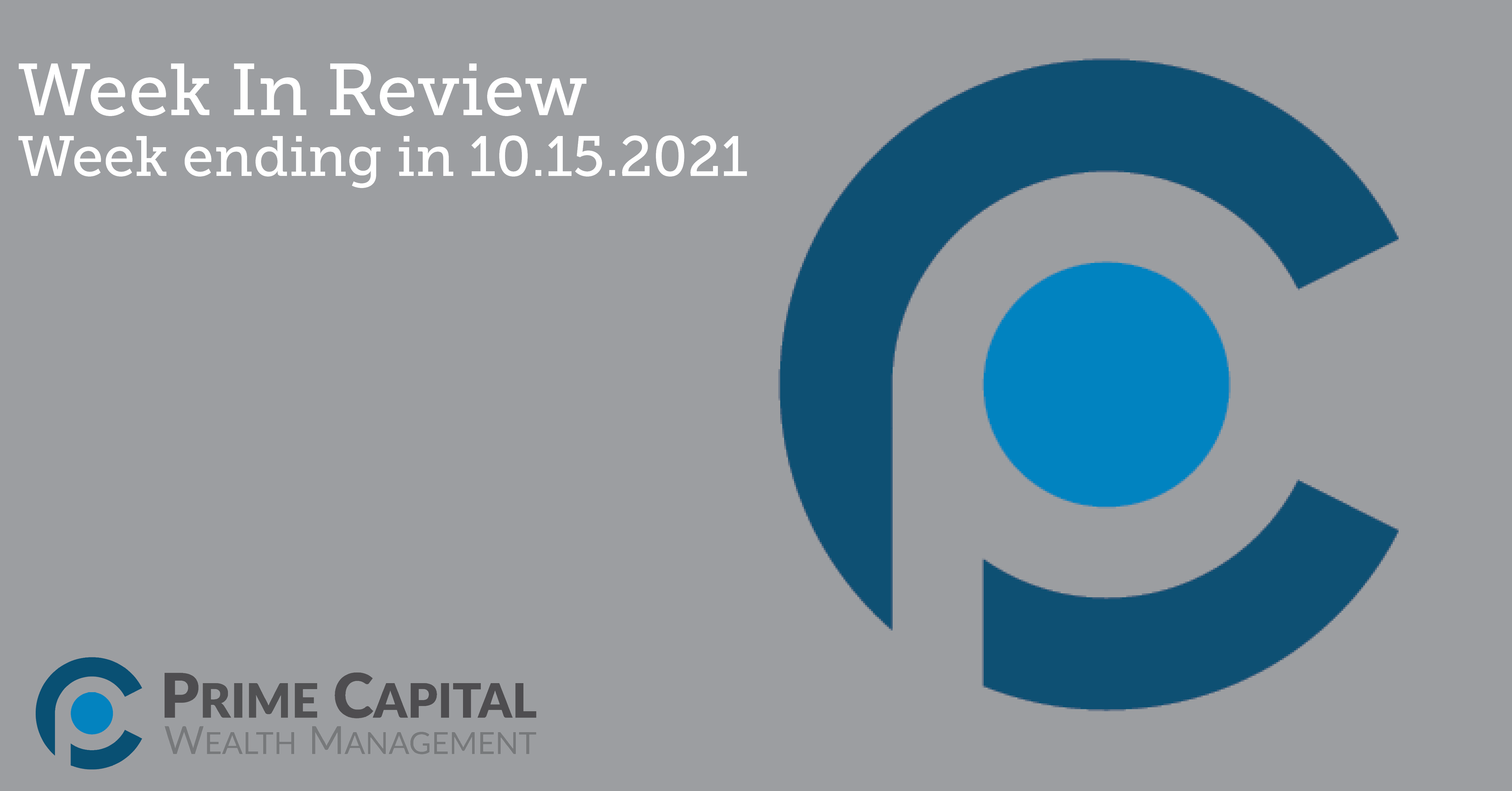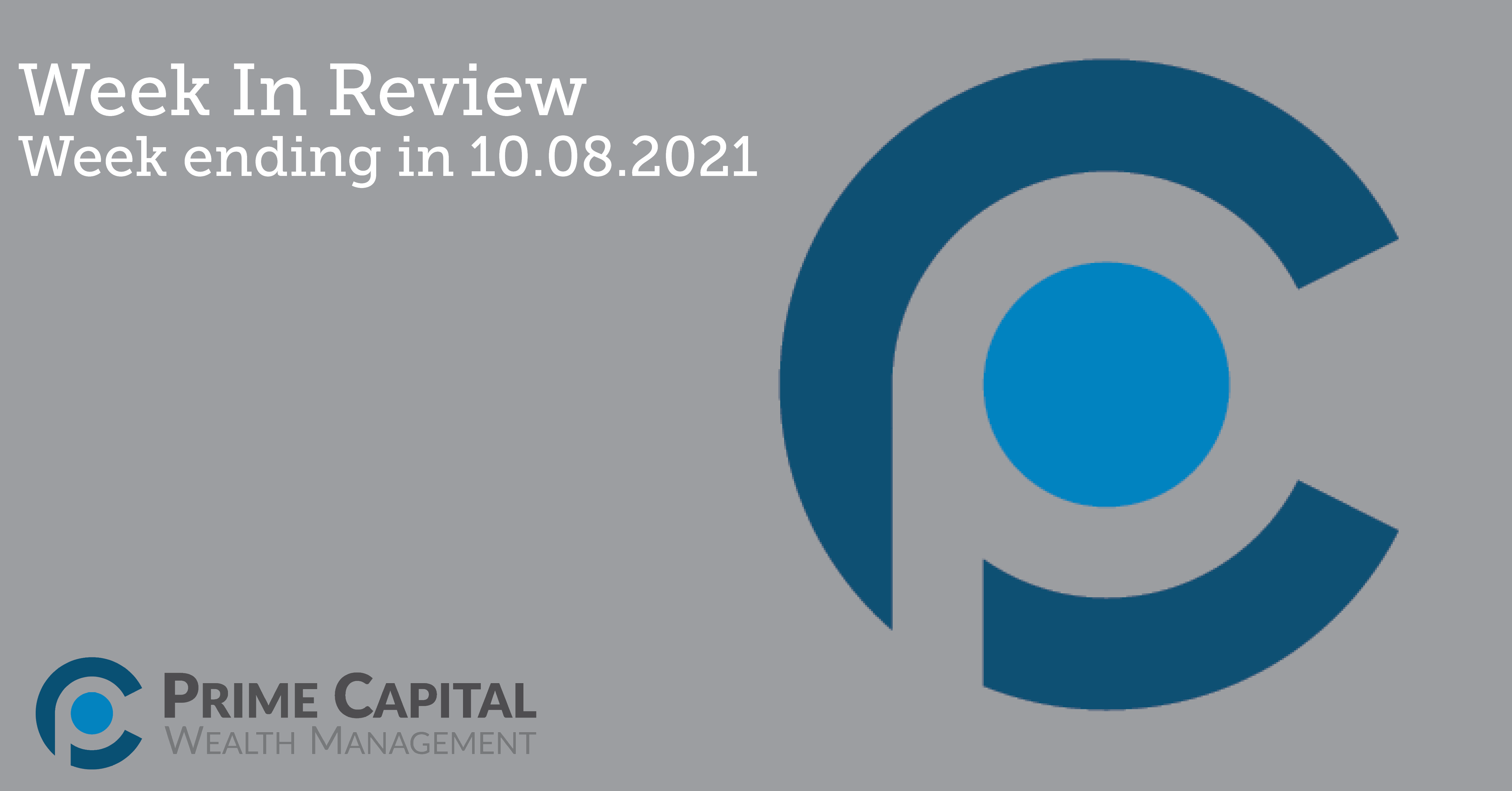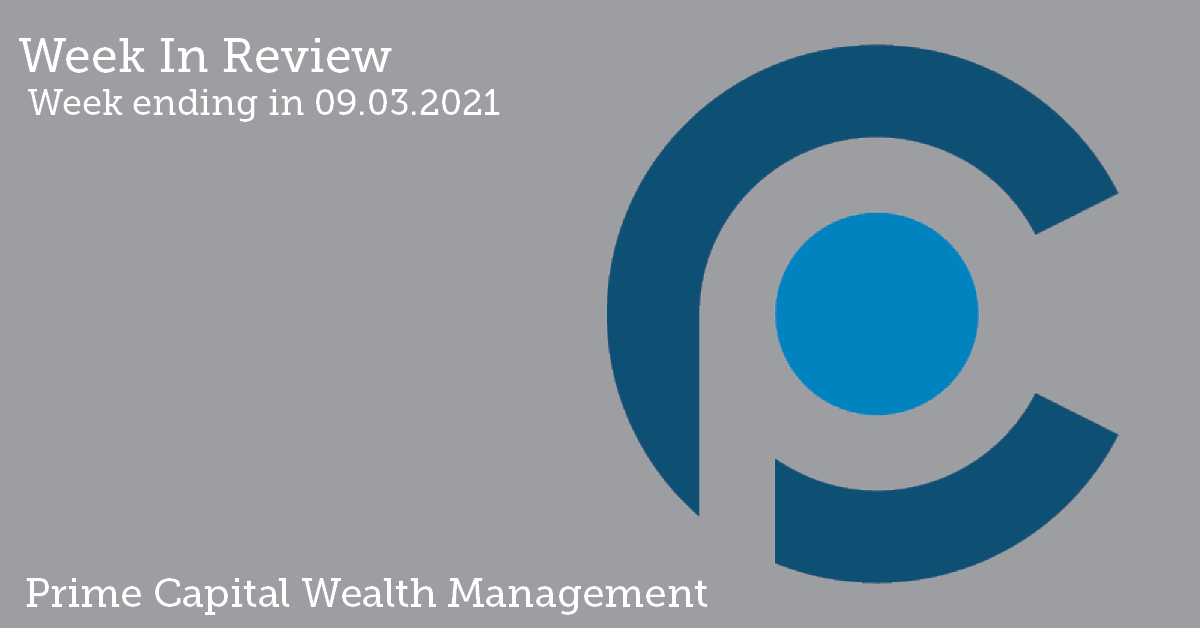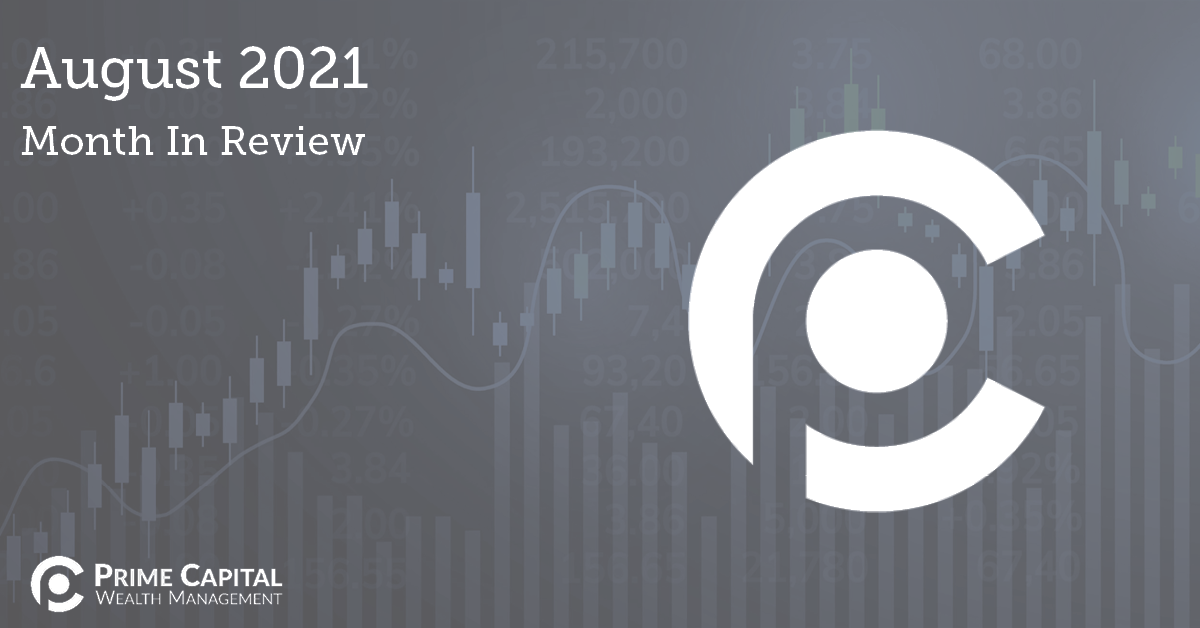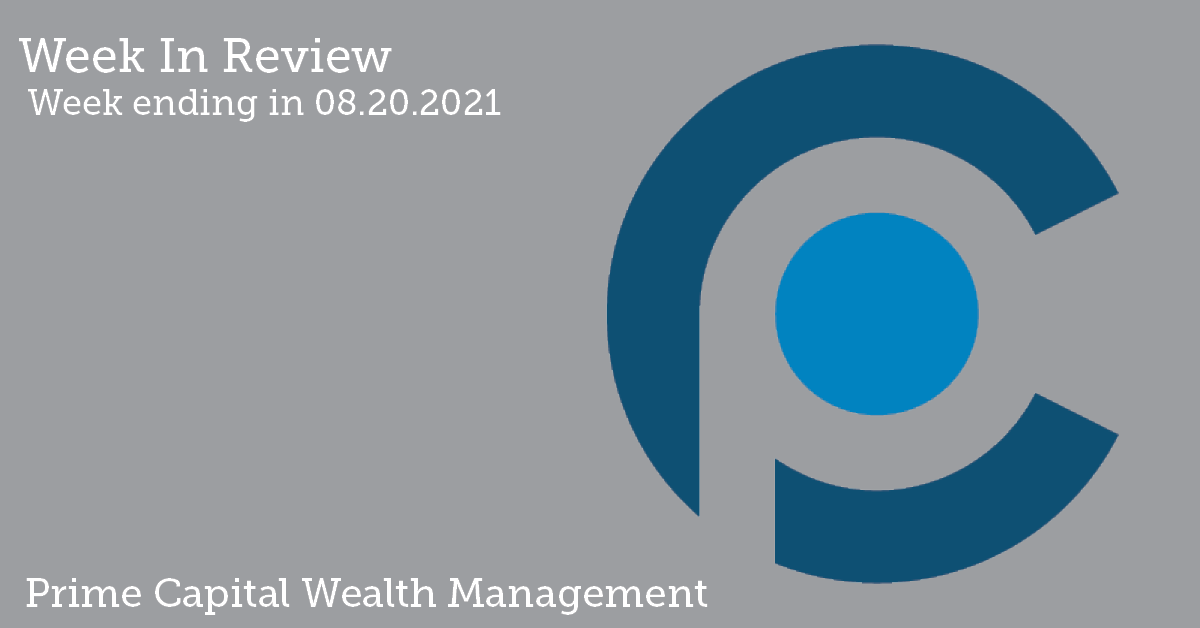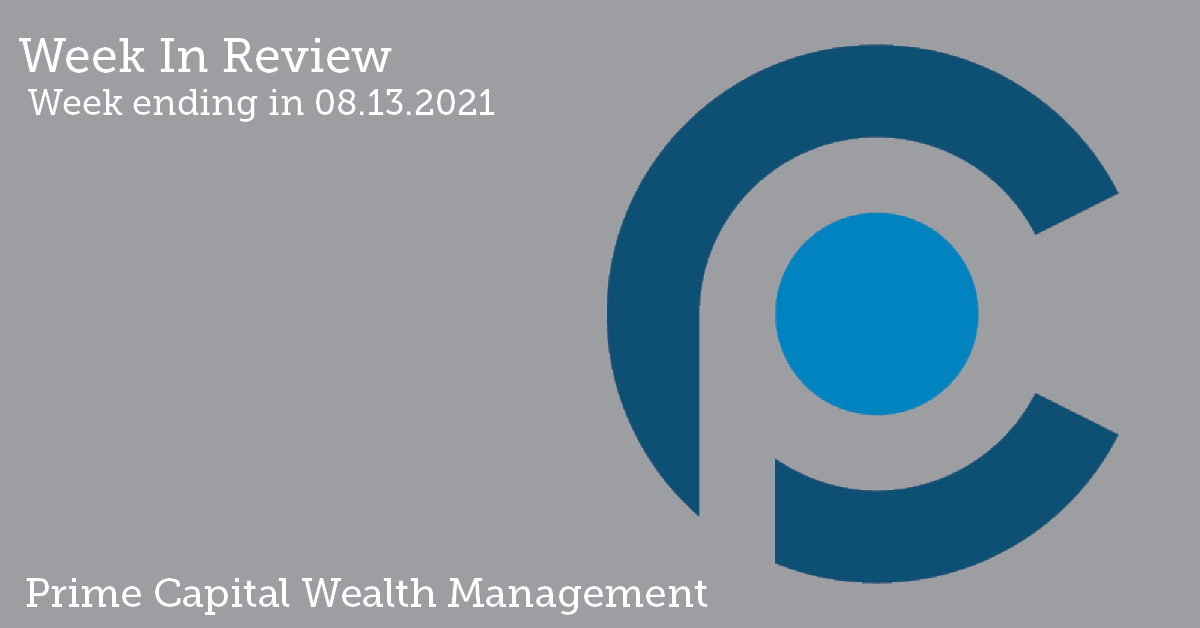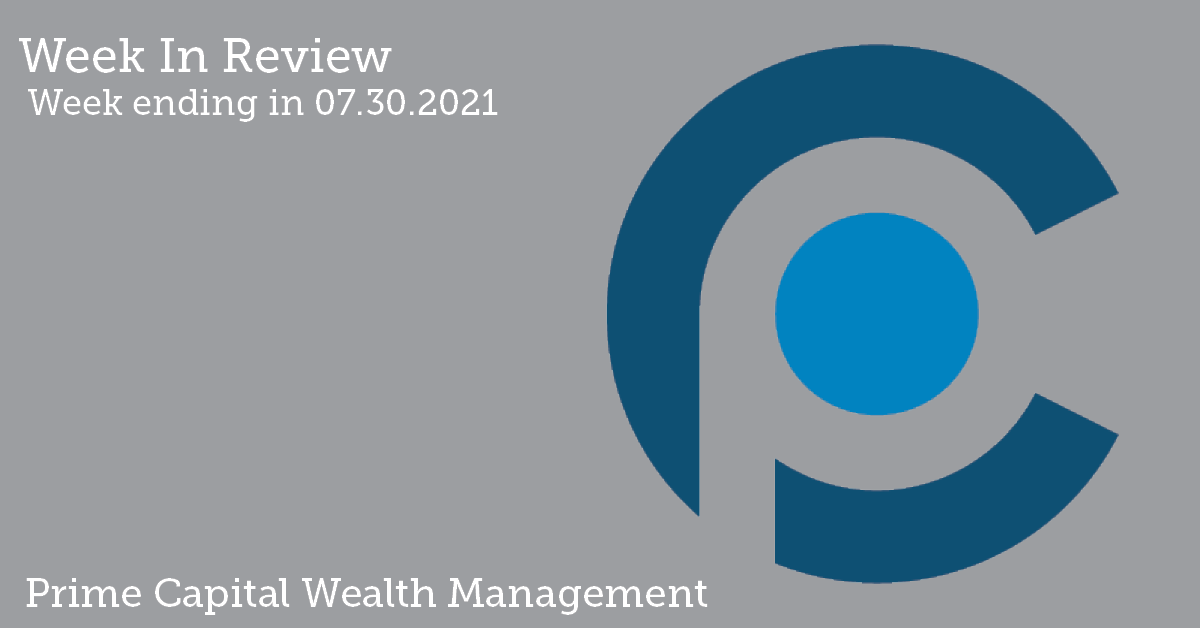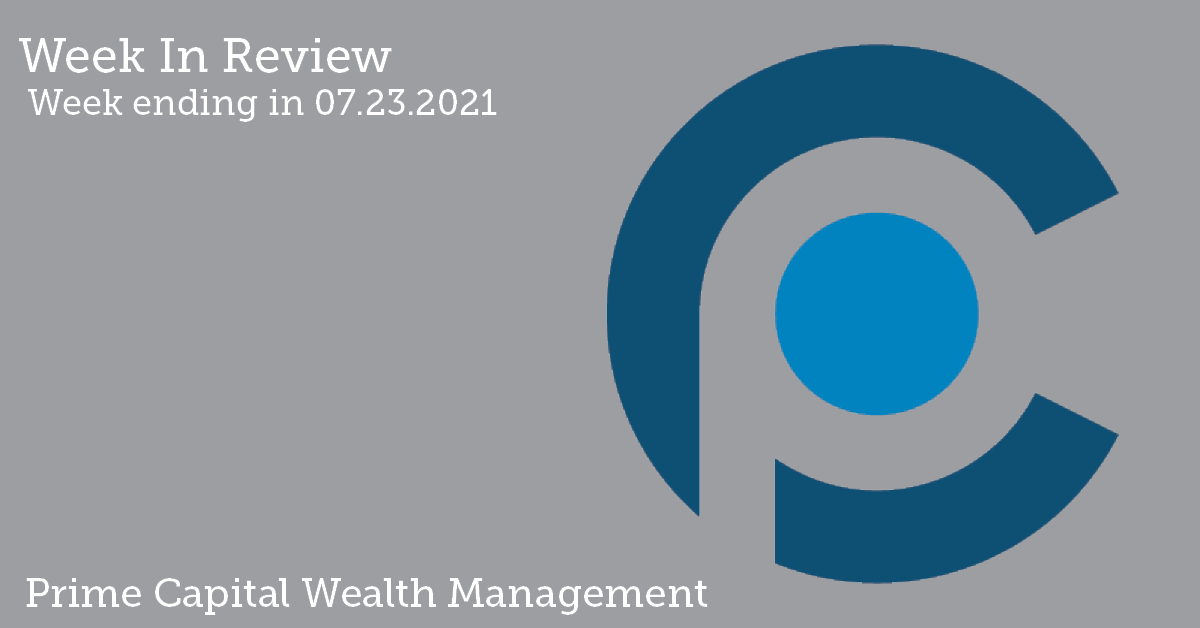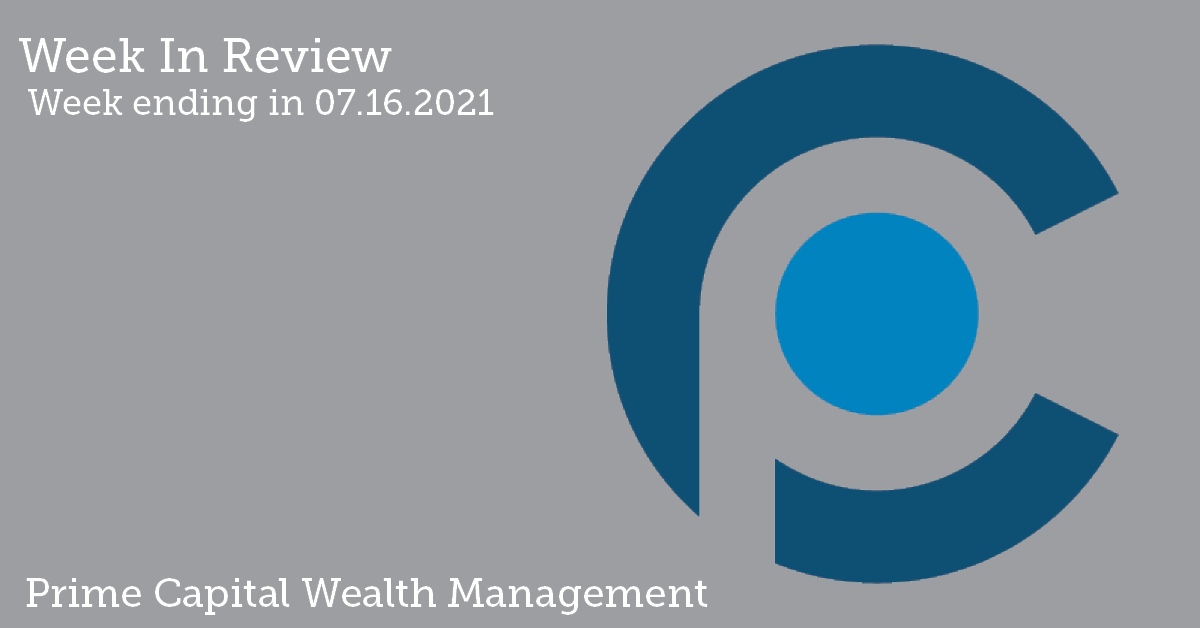Equities posted a strong week as earning announcements began to roll in. International equities outperformed U.S. equities, but all major indices were in the green.
Week-in-Review: Week ending in 10.08.21
Equities were able to claw back some of the losses from the previous weeks, but Small Caps and Japanese equities still fell further.
Week-in-Review: Week ending in 09.03.21
The Bottom Line
● Domestic equities posted another week of gains but lost some momentum after a disappointing payroll release. European equities faltered on political news out of Germany, while Japanese equities rallied around their own political news.
● Treasury yields fell on the shorter-end with the 2-Year falling -1bps, but the longer-end rose slightly with the 10-Year gaining +1bps.
● Economic news for the week painted a blurry picture with the housing market showing signs of cooling, solid manufacturing that is being stifled by labor and parts shortages, and a gigantic miss on payroll numbers.
Is Growth Slowing?
For most of the week, equity markets were able to grind higher, but started to lose their footing after payroll numbers posted a massive disappointment. Despite this falter, domestic equities were all in the green with the S&P up+0.58%, the Nasdaq up +1.55%, and the Russell posting a gain of +0.65% for the week. European equities couldn’t hold onto their gain and fell -0.09% for the week after political turmoil emerged in Germany. Japanese equities rallied after Yoshihide Suga announced he is stepping down from leadership, but his party will remain in control. The Nikkei was up a whopping +5.38% for the week, most of which was achieved on Friday. Economic releases painted a mixed picture going into the long holiday weekend, with manufacturing showing strong output, but constrained from labor and supply chain shortages, housing markets cooled for the second month in a row, and wages grew but didn’t take employment with it. Market participants will be keeping a close eye on growth metrics and will be paying especially close attention to labor markets looking for any signs of trending weakness that could derail the Fed’s targeted plan to start tapering asset purchases at the end of this year.
Digits & Did You Knows
BRAND NEW HOMES — The median sales price of a new home sold in the USA in June 2021 was $390,500, a record high both on a nominal basis and on an inflation-adjusted basis. The old nominal record was $374,400 in April 2021. The old inflation-adjusted record was $345,800 in May 2017, equal to $383,898 in today’s dollars. (source: Census Bureau, BTN Research).
RED TAPE — Congress approved $46.55 billion in rental aid via 2 bills in 12/2020 and 3/2021. As of 08/25/2021, just $5.1 billion has been disbursed to renters or 11% of the total. (source: Emergency Rental Assistance Program, BTN Research).
THE FIRST ONE — The CDC has changed the date of the first US Covid-19 death from 02/06/2020 to as early as 01/11/2020. The CDC now believes 6 Covid-related deaths occurred before 02/06/2020. (source: CDC, BTN Research).
Click here to see the full review.
—
Source: Bloomberg. Asset‐class performance is presented by using market returns from an exchange‐traded fund (ETF) proxy that best represents its respective broad asset class. Returns shown are net of fund fees for and do not necessarily represent performance of specific mutual funds and/or exchange‐traded funds recommended by the Prime Capital Investment Advisors. The performance of those funds may be substantially different than the performance of the broad asset classes and to proxy ETFs represented here. U.S. Bonds (iShares Core U.S. Aggregate Bond ETF); High‐YieldBond(iShares iBoxx $ High Yield Corporate Bond ETF); Intl Bonds (SPDR® Bloomberg Barclays International Corporate Bond ETF); Large Growth (iShares Russell 1000 Growth ETF); Large Value (iShares Russell 1000 ValueETF);MidGrowth(iSharesRussell Mid‐CapGrowthETF);MidValue (iSharesRussell Mid‐Cap Value ETF); Small Growth (iShares Russell 2000 Growth ETF); Small Value (iShares Russell 2000 Value ETF); Intl Equity (iShares MSCI EAFE ETF); Emg Markets (iShares MSCI Emerging Markets ETF); and Real Estate (iShares U.S. Real Estate ETF). The return displayed as “Allocation” is a weighted average of the ETF proxies shown as represented by: 30% U.S. Bonds, 5% International Bonds, 5% High Yield Bonds, 10% Large Growth, 10% Large Value, 4% Mid Growth, 4%Mid Value, 2% Small Growth, 2% Small Value, 18% International Stock, 7% Emerging Markets, 3% Real Estate.
Advisory services offered through Prime Capital Investment Advisors, LLC. (“PCIA”), a Registered Investment Adviser. PCIA doing business as Prime Capital Wealth Management (“PCWM”) and Qualified Plan Advisors (“QPA”).
© 2021 Prime Capital Investment Advisors, 6201 College Blvd., 7th Floor, Overland Park, KS 66211.
Month-in-Review: August 2021
Quick Takes
● Steady ascent. Despite higher COVID cases, rising geopolitical risks, mounting inflation fears, the looming Fed tapering, and waning economic growth, stocks continued their steady ascent with the S&P 500 closing August just below its all-time high.
● Delta damage. With Delta progressively spreading throughout the month, August saw a pullback in consumer activity, with notable declines in visits to Gyms, Grocery Stores, Restaurants, and Retailers. Air passenger traffic also rolled over in August after nearing pre-pandemic levels in June and July.
● Earnings exploding. With less than a handful of companies left to report earnings for the second quarter of 2021, data from FactSet shows the reported year-over-year growth in earnings is 91%–the highest growth since the fourth quarter of 2009.
● Expectations eroding. In the first two quarters of the year, economic results were consistently exceeding expectations. Since the beginning of July, and gaining downside momentum in August, a reversal of this dynamic has resulted in the vast majority of economic data now falling short of expectations.
Asset Class Performance
Returns for most major asset classes were relatively muted in August as U.S. and International Equities were up a bit, while U.S. and International Bonds declined slightly. Bonds are the only asset classes still negative for the year.

Stocks set records despite mixed economics and delta variant
August, traditionally a tepid month for stocks, ended on a high note with the S&P 500 closing at 4,522.68, up from July’s close of 4,395.26 and now the seventh consecutive month of gains. The S&P is now up a healthy +20.41% for 2021. Domestic equities weren’t the only ones to rise during August, European equities rose +1.98% for the month as did Japanese equities, up +2.95% for August. While markets were optimistic, some of the economic releases for the month painted a more mixed picture. On a positive note, CPI metrics came in largely in-line with expectations, which is more consistent with the Fed’s narrative of transitory inflation. Regardless, consumers are beginning to feel the pressures of rising prices and it weighted on Consumer Confidence. The University of Michigan’s Sentiment survey reached its lowest level since 2013 at 70.3. Manufacturing data also retracted, with ISM’s gauge of factory activity falling for a second month in a row, illustrating that supply chain bottlenecks and difficulty hiring labor, especially skilled labor, is still prevalent. Consumers have been hesitant to return to work as the delta variant spread has increased over the summer months, as illustrated in the chart below.
 Additionally, the fear of mask mandates and lockdowns returning has curbed consumer spending which fell to +0.3%for the month of July, missing expectations of +0.4%, and well below the prior month’s release of +1.1%. The miss on Consumer Spending came from softer than expected retail goods and automobiles, but service spending increased. If consumer spending continues to soften into the second half of the year, it could lead to stagnating the economic recovery. Despite consumers pessimism, Incomes surged +1.1%, crushing expectations of +0.3%. The advance was due to Child Tax Credit payments, which more than offset a decline in unemployment benefits, which have been tapering off in recent months as the economic recovery progresses. Overall, consumers remain in one of the best financial standpoints in history. Consumers aren’t alone, corporations are posting some of their strongest earnings in history. As earnings season wound down at the end of August, S&P 500 constituents posted a revenue surprise of 4.9% in aggregate,
Additionally, the fear of mask mandates and lockdowns returning has curbed consumer spending which fell to +0.3%for the month of July, missing expectations of +0.4%, and well below the prior month’s release of +1.1%. The miss on Consumer Spending came from softer than expected retail goods and automobiles, but service spending increased. If consumer spending continues to soften into the second half of the year, it could lead to stagnating the economic recovery. Despite consumers pessimism, Incomes surged +1.1%, crushing expectations of +0.3%. The advance was due to Child Tax Credit payments, which more than offset a decline in unemployment benefits, which have been tapering off in recent months as the economic recovery progresses. Overall, consumers remain in one of the best financial standpoints in history. Consumers aren’t alone, corporations are posting some of their strongest earnings in history. As earnings season wound down at the end of August, S&P 500 constituents posted a revenue surprise of 4.9% in aggregate,  the largest surprise percentage since FactSet began tracking the metric in 2008 and well above the five-year average of 1.46% (dotted line in the chart above). The unprecedented amount of stimulus distributed by the Fed and Congress has been a significant boon to corporations’ top lines. The Q2 sales growth has helped justify stretched valuations, JPMorgan Asset Management reported S&P 500 YTD earnings growth of 19.7% and multiples have compressed down -5.3%. Despite this compression, P/E ratios remain elevated at 21.5x, versus their 5-year average of 16.3x on the S&P 500.
the largest surprise percentage since FactSet began tracking the metric in 2008 and well above the five-year average of 1.46% (dotted line in the chart above). The unprecedented amount of stimulus distributed by the Fed and Congress has been a significant boon to corporations’ top lines. The Q2 sales growth has helped justify stretched valuations, JPMorgan Asset Management reported S&P 500 YTD earnings growth of 19.7% and multiples have compressed down -5.3%. Despite this compression, P/E ratios remain elevated at 21.5x, versus their 5-year average of 16.3x on the S&P 500.
Bottom Line: Equities continue to grind higher despite lofty valuations, temporary setbacks in the economic recovery due to supply chain constraints and labor shortages, the spread of the delta variant, and hesitant consumers. If trends begin to develop in any of these risks, it may stagnant the economic recovery.
Click here to see the full review.
—
©2021 Prime Capital Investment Advisors, LLC. The views and information contained herein are (1) for informational purposes only, (2) are not to be taken as a recommendation to buy or sell any investment, and (3) should not be construed or acted upon as individualized investment advice. The information contained herein was obtained from sources we believe to be reliable but is not guaranteed as to its accuracy or completeness. Investing involves risk. Investors should be prepared to bear loss, including total loss of principal. Diversification does not guarantee investment returns and does not eliminate the risk of loss. Past performance is no guarantee of comparable future results.
Source: Bloomberg. Asset‐class performance is presented by using market returns from an exchange‐traded fund (ETF) proxy that best represents its respective broad asset class. Returns shown are net of fund fees for and do not necessarily represent performance of specific mutual funds and/or exchange‐traded funds recommended by the Prime Capital Investment Advisors. The performance of those funds may be substantially different than the performance of the broad asset classes and to proxy ETFs represented here. U.S. Bonds (iShares Core U.S. Aggregate Bond ETF); High‐YieldBond(iShares iBoxx $ High Yield Corporate Bond ETF); Intl Bonds (SPDR® Bloomberg Barclays International Corporate Bond ETF); Large Growth (iShares Russell 1000 Growth ETF); Large Value (iShares Russell 1000 ValueETF);MidGrowth(iSharesRussell Mid‐CapGrowthETF);MidValue (iSharesRussell Mid‐Cap Value ETF); Small Growth (iShares Russell 2000 Growth ETF); Small Value (iShares Russell 2000 Value ETF); Intl Equity (iShares MSCI EAFE ETF); Emg Markets (iShares MSCI Emerging Markets ETF); and Real Estate (iShares U.S. Real Estate ETF). The return displayed as “Allocation” is a weighted average of the ETF proxies shown as represented by: 30% U.S. Bonds, 5% International Bonds, 5% High Yield Bonds, 10% Large Growth, 10% Large Value, 4% Mid Growth, 4%Mid Value, 2% Small Growth, 2% Small Value, 18% International Stock, 7% Emerging Markets, 3% Real Estate.
Advisory services offered through Prime Capital Investment Advisors, LLC. (“PCIA”), a
Registered Investment Adviser. PCIA doing business as Prime Capital Wealth Management
(“PCWM”) and Qualified Plan Advisors (“QPA”).
© 2021 Prime Capital Investment Advisors, 6201 College Blvd., 7th Floor, Overland Park, KS 66211.
Week-in-Review: Week ending in 08.27.21
The Bottom Line
● The S&P and Nasdaq rose to record levels after Fed Chairman Powell’s comments post Jackson Hole Symposium. Small Cap equities were the biggest winner for the week, gaining +5.05% as investors went risk on.
● Treasury yields were volatile leading up to Powell’s comments but settled after his dovish tone. The 2-year yield dropped -1 bps, but the 10-year yield climbed +5 bps higher for the week.
● Economic news for the week illustrated that supply constraints haven’t abated with orders of goods still outpacing shipments and inflation and delta variant spread is still weighing on consumers’ minds.
Powell Soothes Markets
Investors were able to breathe a sigh of relief after Fed Chairman Powell’s dovish comments on Fed policy moving forward. Markets were mainly concerned over the tapering of asset purchases leading directly into a rate hike. Powell quelled these fears by clearly stating that tapering did not mean hiking. Rejuvenated by this reassurance, traders resumed a risk on mode sending the S&P and Nasdaq to record highs, the S&P ended the week up +1.52% and the Nasdaq was up +2.82%. The S&P is now at a healthy +20.06%return for 2021 thus far and the Nasdaq isn’t far behind at + 17.39% YTD. Small Cap equities were the dominant index for the week, up a whopping +5.05% for the week and + 15.31% YTD. Powell’s comments were heard far and wide with international indexes rising as well. The STOXX Europe 600 gained +0.76% for the week and is now up +18.37% for the year. Troubled Japanese equities were able to catch a bid and returned to positive territory for the year, up +2.32% for the week and now up +0.72% YTD. Yields were ripe with speculation over the Fed’s policy and its effect on the economic recovery, but ultimately, the short end of the curve fell -1 bps and the 10-year yield rose +5 bps.
Digits & Did You Knows
MONTHLY BENEFIT — 54 million Americans receive monthly Social Security retirement benefits, including retired workers, dependents of retired workers, and survivors of deceased workers. 42 million Americans receive monthly assistance from the Supplemental Nutrition Assistance Program (SNAP), aka “food stamps”. (source: SNAP, BTN Research).
AFGHANISTAN — The United States spent $2.26 trillion during its 20-year presence in Afghanistan in fighting the Taliban, rebuilding the Afghan government, and training the Afghan military. (source: Brown University, BTN Research).
SKIP THE PUMP — There are 43,600 electric vehicle (EV) charging stations in the USA. The $1.2 trillion infrastructure bill passed by the Senate allocates $7.5 billion for additional charging stations.(source: DOE, BTN Research).

Click here to see the full review.
—
Source: Bloomberg. Asset‐class performance is presented by using market returns from an exchange‐traded fund (ETF) proxy that best represents its respective broad asset class. Returns shown are net of fund fees for and do not necessarily represent performance of specific mutual funds and/or exchange‐traded funds recommended by the Prime Capital Investment Advisors. The performance of those funds may be substantially different than the performance of the broad asset classes and to proxy ETFs represented here. U.S. Bonds (iShares Core U.S. Aggregate Bond ETF); High‐YieldBond(iShares iBoxx $ High Yield Corporate Bond ETF); Intl Bonds (SPDR® Bloomberg Barclays International Corporate Bond ETF); Large Growth (iShares Russell 1000 Growth ETF); Large Value (iShares Russell 1000 ValueETF);MidGrowth(iSharesRussell Mid‐CapGrowthETF);MidValue (iSharesRussell Mid‐Cap Value ETF); Small Growth (iShares Russell 2000 Growth ETF); Small Value (iShares Russell 2000 Value ETF); Intl Equity (iShares MSCI EAFE ETF); Emg Markets (iShares MSCI Emerging Markets ETF); and Real Estate (iShares U.S. Real Estate ETF). The return displayed as “Allocation” is a weighted average of the ETF proxies shown as represented by: 30% U.S. Bonds, 5% International Bonds, 5% High Yield Bonds, 10% Large Growth, 10% Large Value, 4% Mid Growth, 4%Mid Value, 2% Small Growth, 2% Small Value, 18% International Stock, 7% Emerging Markets, 3% Real Estate.
Advisory services offered through Prime Capital Investment Advisors, LLC. (“PCIA”), a Registered Investment Adviser. PCIA doing business as Prime Capital Wealth Management (“PCWM”) and Qualified Plan Advisors (“QPA”).
© 2021 Prime Capital Investment Advisors, 6201 College Blvd., 7th Floor, Overland Park, KS 66211.
Week-in-Review: Week ending in 08.20.21
The Bottom Line
● Markets threw a mini tantrum this week as speculation over tapering to the Fed’s asset purchase programs abounded. All major US and International indices finished the week in the red, Emerging Market equities took the brunt of the sell-off.
● The 2-year yield rose 2bps for the week, but the 10-year yield fell -2bps as investors searched for risk havens.
● Economic news painted a mixed picture this week, with supply chain constraints and labor shortages causing housing starts to hit a three-month low, but initial jobless claims declined for a fourth week in a row.
Are Markets Throwing A Tantrum?
Speculation surrounding the tapering of the Fed’s asset purchase programs led investors to go risk off this week and fears over the spread of the delta variant and its potential economic impact gave this move some legs, although some of the harder hit regions have reported a slow-down in hospitalizations. Markets were on pace for almost an entirely red week but were given some reprieve when the President of the Dallas Fed said his views on tapering may change, he has been in favor of starting to taper sooner rather than later. The S&P faired the best over the week, but still lost -0.59%, followed by the Nasdaq which lost -0.73% for the week. Small Caps, as measured by the Russell 2000, were down every day of the week until Friday, but Friday wasn’t near enough to bring them back to positive territory with the index tumbling -2.50% for the week. International markets were not immune to the sell-off with Japanese equities losing -3.45% for the week, now down -1.57% YTD. European equities cooled their summer rally, down -1.48% for the week, its worst week since February. China’s government continued to reign in Big Tech with more regulation, which coupled with a rising US dollar brought the Emerging Markets index down -4.31% for the week.
Digits & Did You Knows
MOVE HERE — 44 US Cities are currently offering cash incentives to attract workers to move to their cities, including, Augusta, ME ($15,660), Stillwater, OK ($7,500), and French Lick, IN ($5,000).(source: MakeMyMove.com, BTN Research).
MOST SUSCEPTIBLE — As of 08/11/21, 79% of America Covid-19 deaths occurred to individuals at least age 65, while less than 2% of the victims were under the age of 40. (source: CDC, BTN Research).
WILL IT BE AVERAGE? — The avg. change that American homeowners are anticipating in the value of their primary residence over the upcoming 12-months is a gain of +5.1%, more than the actual gain of +4.1% per year that has been achieved over the last 20-years through 4/30/21. (source: July 2021 Survey of Consumer Expectations Housing Survey, Federal Housing Finance Agency, BTN Research).

Click here to see the full review.
—
Source: Bloomberg. Asset‐class performance is presented by using market returns from an exchange‐traded fund (ETF) proxy that best represents its respective broad asset class. Returns shown are net of fund fees for and do not necessarily represent performance of specific mutual funds and/or exchange‐traded funds recommended by the Prime Capital Investment Advisors. The performance of those funds may be substantially different than the performance of the broad asset classes and to proxy ETFs represented here. U.S. Bonds (iShares Core U.S. Aggregate Bond ETF); High‐YieldBond(iShares iBoxx $ High Yield Corporate Bond ETF); Intl Bonds (SPDR® Bloomberg Barclays International Corporate Bond ETF); Large Growth (iShares Russell 1000 Growth ETF); Large Value (iShares Russell 1000 ValueETF);MidGrowth(iSharesRussell Mid‐CapGrowthETF);MidValue (iSharesRussell Mid‐Cap Value ETF); Small Growth (iShares Russell 2000 Growth ETF); Small Value (iShares Russell 2000 Value ETF); Intl Equity (iShares MSCI EAFE ETF); Emg Markets (iShares MSCI Emerging Markets ETF); and Real Estate (iShares U.S. Real Estate ETF). The return displayed as “Allocation” is a weighted average of the ETF proxies shown as represented by: 30% U.S. Bonds, 5% International Bonds, 5% High Yield Bonds, 10% Large Growth, 10% Large Value, 4% Mid Growth, 4%Mid Value, 2% Small Growth, 2% Small Value, 18% International Stock, 7% Emerging Markets, 3% Real Estate.
Advisory services offered through Prime Capital Investment Advisors, LLC. (“PCIA”), a Registered Investment Adviser. PCIA doing business as Prime Capital Wealth Management (“PCWM”) and Qualified Plan Advisors (“QPA”).
© 2021 Prime Capital Investment Advisors, 6201 College Blvd., 7th Floor, Overland Park, KS 66211.
Week-in-Review: Week ending in 08.13.21
The Bottom Line
● U.S. Consumer Sentiment fell to its lowest level in 11 years, dragging the NASDAQ and Russell into a negative week. The S&P and Foreign equities were able to post a positive week.
● The 10-Year and 2-year yield ebbed and flowed this week before finally settling down -2bps and flat, respectively.
● Economic news was light, but impactful, for the week with CPI numbers showing some moderation, but the PPI numbers still show signs of hot inflation. JOLTS numbers exceeded expectations, demonstrating the troubling labor markets.
Halloween in August
Friday the 13th did not spook the S&P for the week with the index up +0.71% for the week. Foreign equities posted solid gains as well with the STOXX Europe 600 up +1.25% and the Nikkei up +0.56% for the week. European equities were bolstered by French stocks, which are close to attaining a level not seen in 21 years. Small Caps and the tech heavy Nasdaq were frightened into negative territory for the week losing -1.10% and -0.09% respectively. Markets were relieved on Wednesday with CPI numbers meeting expectations, instead of surpassing them. This added ammo to the Fed’s narrative that fast-rising inflation is transitory and will begin to moderate once labor and supply chain issues resolve. However, consumers are fearing the threat of more persistent inflation with the U. of Michigan’s Consumer Sentiment survey showing deteriorating views on future economic growth, future conditions fell by -13.8 index points and current conditions only fell by -6.6 index points. The spread of the delta variant is also weighing on consumer optimism with the fear of mask mandates returning and possible future lockdowns. Corporate earnings have been accompanied with warnings that the spreading delta variant could impact bottom lines.
Digits & Did You Knows
HOME BUILDING — 563,400 single family homes began construction during the first half of 2021, the largest “January-to-June” total in the US Since the first half of 2007 or 14 years earlier.(source: Census Bureau, BTN Research).
THEY MAY NEVER STOP — The Federal Reserve has been buying$120 billion of federal debt per month since mid-March 2020, resulting in our nation’s central bank buying 76% of all the federal debt that has been issued during the pandemic. (source Federal Reserve, BTN Research).
NEED HELP — 43% of Americans under age 35 receive financial help from their parents or other family members when they purchase a home, e.g., money used for a down payment. (source: Legal & General, BTN Research

Click here to see the full review.
—
Source: Bloomberg. Asset‐class performance is presented by using market returns from an exchange‐traded fund (ETF) proxy that best represents its respective broad asset class. Returns shown are net of fund fees for and do not necessarily represent performance of specific mutual funds and/or exchange‐traded funds recommended by the Prime Capital Investment Advisors. The performance of those funds may be substantially different than the performance of the broad asset classes and to proxy ETFs represented here. U.S. Bonds (iShares Core U.S. Aggregate Bond ETF); High‐YieldBond(iShares iBoxx $ High Yield Corporate Bond ETF); Intl Bonds (SPDR® Bloomberg Barclays International Corporate Bond ETF); Large Growth (iShares Russell 1000 Growth ETF); Large Value (iShares Russell 1000 ValueETF);MidGrowth(iSharesRussell Mid‐CapGrowthETF);MidValue (iSharesRussell Mid‐Cap Value ETF); Small Growth (iShares Russell 2000 Growth ETF); Small Value (iShares Russell 2000 Value ETF); Intl Equity (iShares MSCI EAFE ETF); Emg Markets (iShares MSCI Emerging Markets ETF); and Real Estate (iShares U.S. Real Estate ETF). The return displayed as “Allocation” is a weighted average of the ETF proxies shown as represented by: 30% U.S. Bonds, 5% International Bonds, 5% High Yield Bonds, 10% Large Growth, 10% Large Value, 4% Mid Growth, 4%Mid Value, 2% Small Growth, 2% Small Value, 18% International Stock, 7% Emerging Markets, 3% Real Estate.
Advisory services offered through Prime Capital Investment Advisors, LLC. (“PCIA”), a Registered Investment Adviser. PCIA doing business as Prime Capital Wealth Management (“PCWM”) and Qualified Plan Advisors (“QPA”).
© 2021 Prime Capital Investment Advisors, 6201 College Blvd., 7th Floor, Overland Park, KS 66211
Week-in-Review: Week ending in 07.30.21
The Bottom Line
● U.S. equities, save for the Russell, lost their footing for the week and were in the red. Despite the negative week, the S&P was up for the month of July, the sixth consecutive month in the green.
● The 2- and 10-Year yield both resumed their downward trend, falling -1bps and -5bps respectively .
● The week was heavy with economic data releases, including a miss on GDP, strong consumer income and spending numbers, and the FOMC interest rate decision and Powell’s press conference on the meeting
Duck, Duck, Dove
To no surprise, the FOMC left rates at near 0.0%. What markets have been more interested of late is the language surrounding their decision. Investors are searching for any clues as to when and how the Fed will begin to taper its purchase of assets. The Fed is still looking for “substantial further progress” in the economic recovery, but did admit that progress is occurring. Markets ultimately shrugged off Chairman Powell’s comments on Wednesday and Thursday with most major US and international indices posting a positive return on Thursday. The major indices weren’t able to carry their upward momentum into Friday and all ended the week down, with the exception of the Russell and European equities, both up for the week at +0.75% and+0.05% respectively. The Nasdaq lost the most, posting a -1.11% decline, followed closely by Japanese equities with the Nikkei losing -0.96%, and the S&P lost -0.37% for the week. Yields resumed their decline as well with both the 2-and 10-year Treasury Notes declining by -1bps and -5bps respectively. Despite the downturn on Friday, the S&P has advanced for the past six months in a row and all major US and International indices have posted healthy year to date returns, with the Nikkei being the exception at -0.59%.
Digits & Did You Knows
NEXT MONTH — August has been the 2nd worst performing month for the S&P 500 index over the last 30 years (1999-2020), losing and average of -0.2% (total return) over the period. However, the S&P 500 gained +7.2% (total return) in August 2020. (source: BTN Research)
THE HIGH COST OF CARE — 12% of US retirees, i.e., 1 out of 8, will spend at least 4 years in a nursing home. (source: Bureau of labor Statistics, BTN Research)
CHEAPER NOW — The median 2-bedroom apartment in San Francisco cost $3,146 per month in March 2020, but has dropped 14% to $2,695 per month as of July 2021. (source: www.apartmentlist.com, BTN Research)

Click here to see the full review.
—
Source: Bloomberg. Asset‐class performance is presented by using market returns from an exchange‐traded fund (ETF) proxy that best represents its respective broad asset class. Returns shown are net of fund fees for and do not necessarily represent performance of specific mutual funds and/or exchange‐traded funds recommended by the Prime Capital Investment Advisors. The performance of those funds may be substantially different than the performance of the broad asset classes and to proxy ETFs represented here. U.S. Bonds (iShares Core U.S. Aggregate Bond ETF); High‐YieldBond(iShares iBoxx $ High Yield Corporate Bond ETF); Intl Bonds (SPDR® Bloomberg Barclays International Corporate Bond ETF); Large Growth (iShares Russell 1000 Growth ETF); Large Value (iShares Russell 1000 ValueETF);MidGrowth(iSharesRussell Mid‐CapGrowthETF);MidValue (iSharesRussell Mid‐Cap Value ETF); Small Growth (iShares Russell 2000 Growth ETF); Small Value (iShares Russell 2000 Value ETF); Intl Equity (iShares MSCI EAFE ETF); Emg Markets (iShares MSCI Emerging Markets ETF); and Real Estate (iShares U.S. Real Estate ETF). The return displayed as “Allocation” is a weighted average of the ETF proxies shown as represented by: 30% U.S. Bonds, 5% International Bonds, 5% High Yield Bonds, 10% Large Growth, 10% Large Value, 4% Mid Growth, 4%Mid Value, 2% Small Growth, 2% Small Value, 18% International Stock, 7% Emerging Markets, 3% Real Estate.
Advisory services offered through Prime Capital Investment Advisors, LLC. (“PCIA”), a Registered Investment Adviser. PCIA doing business as Prime Capital Wealth Management (“PCWM”) and Qualified Plan Advisors (“QPA”).
© 2021 Prime Capital Investment Advisors, 6201 College Blvd., 7th Floor, Overland Park, KS 66211.
Week-in-Review: Week ending in 07.23.21
The Bottom Line
● U.S. equities resumed their uptrend after last week’s decline, with major indices all posting a positive week. The NASDAQ led the pack for the week at +2.84%.
● The 10-Year yield started the week with a steep decline, but reclaimed ground and settled -1 bps below last week’s level at 1.28. The 2-Year yield was also volatile, but settled -2 bps at 0.20.
● Economic releases were on the lighter side, with most of the data releases relating to housing. A negative surprise on jobs came in on Thursday and caused markets to pause.
Muted Celebrations
With the Tokyo Olympics kicking off at the latter part of the week, the world was reminded where we have been and where we are since the start of the global pandemic. Traditionally a time of global celebration, the excitement was dampened by the absence of spectators at the games. Japanese equities had a short trading week due to the games and the Nikkei reflected the worlds’ disappointment by losing another -1.63% for the week. European equities were able to shake off some of the concerns over the spread of the delta variant and rose +1.49% for the week. US equities were able to dig themselves out of a hole after Monday and erase last week’s losses, although the negative surprise on the weekly jobs report on Thursday caused some hesitation. By Friday, the markets shook off the noise and resumed their climb with the tech heavy Nasdaq leading the way at +2.84%for the week, followed by the small cap Russell index at+2.15%. The S&P posted a respectable +1.96% for the week and is still the leader YTD at +17.46%. Markets will be closely watching the announcement and the language surrounding interest rates from the FOMC meeting next week.
Digits & Did You Knows
ARE YOU WEALTHY? — The average response from 1,000 Americans surveyed in the first half of 2021 is that it takes a net worth of $1.9 million in order to be considered “wealthy” in the United States today. (source: Schwab 2021 Modern Wealth Survey, BTN Research)
ONLY ONCE — Inflation, using the “Consumer Price Index” (CPI) as the measurement, was up +5.4% on a trailing 1-year basis as of 06/30/21. In the last 30 years, there was only 1 month when trailing 1-year inflation was greater than +5.4%. Inflation was up +5.6% for the 1-year ending 7/31/08.(source: Department of Labor, BTN Research)

Click here to see the full review.
—
Source: Bloomberg. Asset‐class performance is presented by using market returns from an exchange‐traded fund (ETF) proxy that best represents its respective broad asset class. Returns shown are net of fund fees for and do not necessarily represent performance of specific mutual funds and/or exchange‐traded funds recommended by the Prime Capital Investment Advisors. The performance of those funds may be substantially different than the performance of the broad asset classes and to proxy ETFs represented here. U.S. Bonds (iShares Core U.S. Aggregate Bond ETF); High‐YieldBond(iShares iBoxx $ High Yield Corporate Bond ETF); Intl Bonds (SPDR® Bloomberg Barclays International Corporate Bond ETF); Large Growth (iShares Russell 1000 Growth ETF); Large Value (iShares Russell 1000 ValueETF);MidGrowth(iSharesRussell Mid‐CapGrowthETF);MidValue (iSharesRussell Mid‐Cap Value ETF); Small Growth (iShares Russell 2000 Growth ETF); Small Value (iShares Russell 2000 Value ETF); Intl Equity (iShares MSCI EAFE ETF); Emg Markets (iShares MSCI Emerging Markets ETF); and Real Estate (iShares U.S. Real Estate ETF). The return displayed as “Allocation” is a weighted average of the ETF proxies shown as represented by: 30% U.S. Bonds, 5% International Bonds, 5% High Yield Bonds, 10% Large Growth, 10% Large Value, 4% Mid Growth, 4%Mid Value, 2% Small Growth, 2% Small Value, 18% International Stock, 7% Emerging Markets, 3% Real Estate.
Advisory services offered through Prime Capital Investment Advisors, LLC. (“PCIA”), a Registered Investment Adviser. PCIA doing business as Prime Capital Wealth Management (“PCWM”) and Qualified Plan Advisors (“QPA”).
© 2021 Prime Capital Investment Advisors, 6201 College Blvd., 7th Floor, Overland Park, KS 66211.
Week-in-Review: Week ending in 07.16.21
The Bottom Line
● U.S. equities fell for the first time in four weeks. All the major US equity indices posted a negative return for the week, but still maintain healthy year to date figures.
● The 10-Year yield started the week on the upswing but couldn’t cross the 1.42 level. Ultimately, it resumed it’s decline and ended the week down -7 bps, settling at 1.29.
● The markets had plenty of economic news to digest this week with June inflation data releases, retail sales, labor market reports, and major US banks kicked off earnings season.
Dog Days of Summer
Markets are traditionally tepid during the summer months, and this summer might fall victim to the adage of the “Dog Days of Summer”. The S&P started the week just as it finished last week, carrying an increase of +0.49% up to Wednesday. This didn’t last as inflation metrics came out higher than expected and above consensus estimates on retail sales weren’t able to revive the indices on Friday. The Russell took the brunt of the selling pressure, posting a -5.12% loss for the week. Major US banks reported their earnings, top line numbers were propped up by robust investment banking division revenues, but other segments couldn’t boast similar results. Concerns over the spread of the delta variant continued to weigh on European equities with the STOXX 600 posting a -0.64% loss for the week. After a difficult week last week, Japanese equities were able to post a modest gain of +0.22% for the week. Volatility wasn’t only present in the equity markets, the 10-year yield sent investors on a ride with rates pushing higher at the beginning of the week, but the 10-year wasn’t able to surpass the 1.42 level and finally ended the week down -7bps to 1.29 as investors searched for a haven.
Digits & Did You Knows
IT’S DIFFERENT — The Federal Reserve measures inflation using the “Personal Consumption Expenditures” (PCE) price index while the government uses the “Consumer Price Index” (CPI) for the “cost of living adjustment” (COLA) to increase Social Security retirement benefits. The CPI gives “housing” prices a 42.1%weighting in its calculation, while the PCE gives “housing” just a 22.6% weighting. The CPI gives “medical care” prices an 8.8%weighting in its calculation, while the PCE gives “medical care” a 22.3% weighting. (source: Federal Reserve, BTN Research).
NOT JUST KIDS — 19% of Americans that have outstanding student loan debt from college are over age 50, i.e., 8.7 million borrowers out of 44.7 million total borrowers. (source Federal Reserve Bank of New York, BTN Research).

Click here to see the full review.
—
Source: Bloomberg. Asset‐class performance is presented by using market returns from an exchange‐traded fund (ETF) proxy that best represents its respective broad asset class. Returns shown are net of fund fees for and do not necessarily represent performance of specific mutual funds and/or exchange‐traded funds recommended by the Prime Capital Investment Advisors. The performance of those funds may be substantially different than the performance of the broad asset classes and to proxy ETFs represented here. U.S. Bonds (iShares Core U.S. Aggregate Bond ETF); High‐YieldBond(iShares iBoxx $ High Yield Corporate Bond ETF); Intl Bonds (SPDR® Bloomberg Barclays International Corporate Bond ETF); Large Growth (iShares Russell 1000 Growth ETF); Large Value (iShares Russell 1000 ValueETF);MidGrowth(iSharesRussell Mid‐CapGrowthETF);MidValue (iSharesRussell Mid‐Cap Value ETF); Small Growth (iShares Russell 2000 Growth ETF); Small Value (iShares Russell 2000 Value ETF); Intl Equity (iShares MSCI EAFE ETF); Emg Markets (iShares MSCI Emerging Markets ETF); and Real Estate (iShares U.S. Real Estate ETF). The return displayed as “Allocation” is a weighted average of the ETF proxies shown as represented by: 30% U.S. Bonds, 5% International Bonds, 5% High Yield Bonds, 10% Large Growth, 10% Large Value, 4% Mid Growth, 4%Mid Value, 2% Small Growth, 2% Small Value, 18% International Stock, 7% Emerging Markets, 3% Real Estate.
Advisory services offered through Prime Capital Investment Advisors, LLC. (“PCIA”), a Registered Investment Adviser. PCIA doing business as Prime Capital Wealth Management (“PCWM”) and Qualified Plan Advisors (“QPA”).
© 2021 Prime Capital Investment Advisors, 6201 College Blvd., 7th Floor, Overland Park, KS 66211.

